Another entry into Keychron’s K Max series dropped, and it's a good one. Meet the Keychron K10 Max.
Thanks to a fantastic build, a wealth of hardware and software customization, and some of the best keycaps I’ve used, the K10 Max is a great keyboard for productivity. Some of Keychron’s most responsive switches — Keychron Super Switches — also give the board a gaming edge, making it a solid option for anyone who wants a deck for work and gaming.
The K10 Max is similar to the Keychron V6 ($89), which is by no means a bad thing — it is one of the best mechanical keyboards we’ve tested, after all. The K10 Max, however, drops some key elements (so long, volume knob) while sporting numerous acoustic refinements and a $10 premium.
For the price, full-sized keyboards don’t come much better — this is definitely one of the best wireless keyboards you can buy. But, you should still consider whether the more specific quirks of the K10 Max are as suited to you as they are to me.
Read on for my full Keychron K10 Max review
Keychron K10 Max review: Cheat Sheet
- What is it? A beefy full-size productivity keyboard
- Who is it for? Anyone looking for a great-sounding all-rounder
- What does it cost? The Keychron K10 costs $119 from Amazon, or $114 direct from Keychron
- What do we like? It’s a joy to use, feeling great to type on while looking smart and stylish
- What don’t we like? Typing isn’t as soft, which might not be to your personal preference. You’ll also be spending extra for less compared to the V6
Keychron K10 Max review: Specs
Swipe to scroll horizontally
| Price | $119 (assembled) |
| Switches | Keychron Super Red, Super Brown, Super Banana |
| Hot-swappable | Yes (non-hot-swappable version available) |
| Stabilizers | PCB-mounted screw-in |
| Mount type | Tray |
| Layout | 100%, 104 keys |
| Keycap profile | OSA |
| Case | ABS Plastic |
| Plate | Steel |
| Colors | Black |
| Backlighting | RGB, White |
| Operating System | Windows, macOS |
| Connectivity | Bluetooth, 2.4G Wireless, USB Wired |
| Battery | 4,000mAh |
| Polling rate | 1,000Hz (USB and 2.4Ghz) / 90Hz (Bluetooth) |
| Measurements | 17.61 x 5.5 x 1.6 inches |
| Weight | 3.3 pounds |
Keychron K10 Max review: The ups
The K10 Max is a fine keyboard for the money, providing plenty of customization, an excellent typing experience and surprisingly decent gaming performance thanks to its Keychron Super switches.
Design
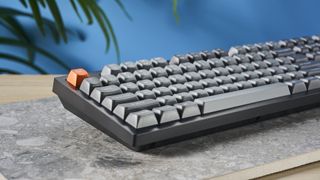
In my eyes, this is one of the best-looking keyboards you can buy without stepping up to a fully metal design. The K10 Max is styled similarly to most of Keychron’s Q and V series of boards, featuring a plain, chunky case. This isn’t bad, as the high-quality plastic and understated style give a premium vibe. There’s a subtle texture to the case plastic, and the gaps in the top case for the keys are perfectly cut to fit.
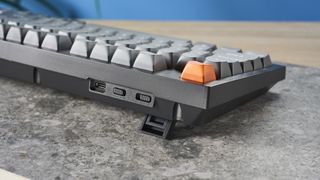
The relatively formal appearance fits perfectly with an office environment or home workstation. However, I appreciate the color highlights on the keyboard. While the V series opts for red Escape and Enter keys against blue/gray keycaps, the K10 instead utilizes the characteristic gray and bright orange scheme of the K series.
The keyboard comes with both macOS and Windows keys. A small switch on the back allows you to switch between the two operating systems freely, which is great if you use both regularly.
Typing experience
Typing on the K10 is everything you could ask for from a mechanical keyboard. Although in typing tests, my speed and accuracy are around average, I found the K10 Max incredibly comfortable to type on. The keycaps have a slightly grainy texture to them, and the concave, rounded shape feels great on my fingertips.
Swipe to scroll horizontally
Rather than the gasket design seen on the majority of Keychron boards, the K10 Max uses a tray-mounted steel plate and PCB assembly. This means that the typing sensation is much harder than on gasket mounts, with keystrokes ending against a barely movable plate, resulting in a noticeable hard stop when the keys bottom out. This won’t be for everyone's tastes, but I didn’t find it a problem even during extended typing sessions.
A benefit of tray mounting is that the entire assembly is more rigid than a gasket mount setup, meaning the K10 Max suffers no PCB movement as you type. That said, you may prefer the softer feel of a gasket-mounted board, especially the super bouncy Keychron Q1 Pro.
Gaming performance
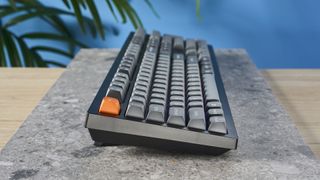
While the K10 Max is a productivity keyboard through and through, it performs surprisingly well for gaming. The Keychron Super switches (red linear switches on my model) are the same switches you can find on the Lemokey L4 and Lemokey P1 Pro among other gaming keyboards, and for good reason. The switches have a soft, albeit long spring, so less force is required to keep it held.
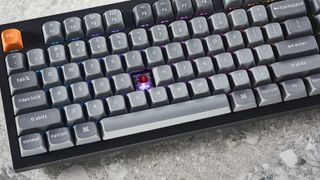
The switches are smooth and fast. You could even take this keyboard into a competitive FPS game and not feel at a serious disadvantage, even compared to bespoke gaming keyboards. The K10 Max holds its own in Counter-Strike 2, with my movements feeling both fluid and responsive. Short of some of the greatest Hall Effect keyboards, like the Keychron K2 HE ($130), these are some of the snappiest switches I have come across.
The tray mounting setup assists with gaming too. Keypresses feel sharp and snappy. Holding down W while jogging in Squad felt much less mushy than on a gasket keyboard.
Sound
One of the most noticeable aspects of the K10 Max (especially if you’re used to the soft, high-pitched taps of the Keychron V1 or V6) is the loud, deep sound.
This is due to a combination of the heavy PBT keycaps hitting the firm tray-mounted plate, alongside three layers of foam on either side of the PCB. The K10 sounds incredible, albeit a little different from the usual Keychron sound, and it makes the stellar typing experience even better.
Customization
Like the rest of the Keychron custom keyboard range, the K10 features extensive hardware and software customization. You can buy a non-hot-swappable version for a $10 discount, which is great if you’re happy with your initial choice of Red, Brown or Banana switches. I am personally set on the Keychron Super red linears for the linear press, but it's not a big enough price difference to justify sacrificing hot-swap flexibility.
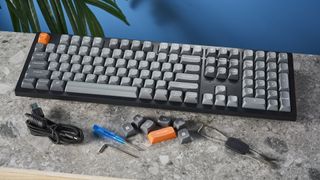
Due to the tray mount design, it’s also a lot easier to modify the internal components of the keyboard. This is especially useful if the sound isn’t to your taste, as you can easily unscrew the steel plate to add or remove acoustic material. This is different from the more complex gasket-mounted case design used in other mechanical keyboards. I found it easier to work from the top down, so this makes me more keen to experiment with the internals of the keyboard.
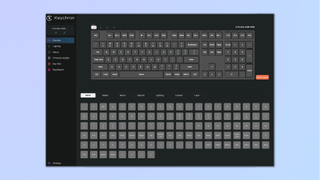
You can fully customize the keyboard’s keybindings, backlighting and macros using the Launcher app. This is convenient since it runs from your web browser, and the clearly laid out UI is easy to navigate. For those after a deeper approach to configuring their keyboard, the firmware supports open-source QMK/VIA, meaning that you can adjust practically any element of the keyboard’s inner workings to your preference.
Keychron K10 Max review: The downs
There isn’t much to criticize but there are some things I’m not fond of, such as the 100% format, the lack of volume control and poor backlighting.
Poor lighting
This is an unfortunate downside to the otherwise stellar appearance and an issue that I have come across on other Keychron boards lately such as the V3 Max ($99). The lighting isn’t very bright, even considering the transparent switch base marketed as enhancing the lighting effect. Unlike other keyboards I have tested, like the Cherry MX 3.1 ($119), the light doesn’t provide a soft glow but is visible as a row of individual lights. You might prefer this but I think this is the main thing Keychron struggles with.
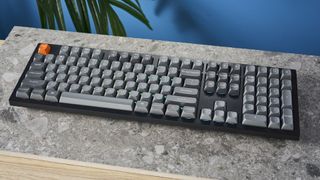
The same can be said for the ugly Caps Lock, Wireless and Num Lock indicator lights located above the arrow keys. While I like to have separate indicators, the light isn’t very clear and appears in garish colors that you cannot adjust.
Size
This is not a fault of the board but should be a pre-purchase condition. If you’ve ever used a full-sized keyboard before, you know that it can dominate desk space. The K10 Max is no exception, stretching a massive 17 inches. If you’re a gamer then you know this limits the amount of space to maneuver your mouse. Those using the keyboard for work will find that the keyboard doesn’t pair well with a busier (A.K.A messier) workstation.
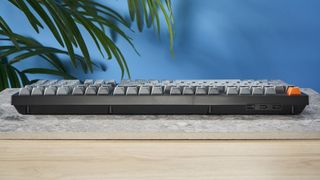
If you think a large keyboard may impact your gaming or productivity, I recommend a versatile 75% layout like the Keychron K2 HE ($130) or NuPhy Halo75 V2 ($129) to save on desk real estate.
Even if you don’t use the adjustable legs, the keyboard has a tall profile. Without a wrist rest, your wrists will tire after being in an upward angle for too long.
Volume Knob
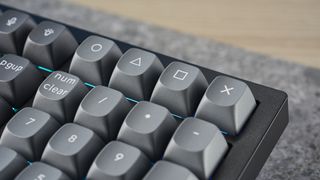
Considering that the keyboard uses a very similar format and design to the V6, it is disappointing to see the lack of a volume knob. While this won’t be an issue for most people, it is still a little sad to have one less customizable option. You do get four rebindable keys in the upper right of the keyboard, though, which might be more practical if you rebind them for media control. That said, sticking to the function keys works just fine.
Keychron K10 Max review: Verdict
The K10 Max is not the most original keyboard, but its subtle refinements make it a great peripheral. This is most evident in the keyboard’s sound, especially compared to the rest of Keychron’s keyboard range. The added layers of foam make all the difference in creating a rich, thocky noise while typing.
This is a great entry point to productivity keyboards if you want something that will sound great out of the box and hash some of the best key switches for productivity and gaming. A simple yet stand-out design and Keychron’s typically strong build quality make the K10 Max a keyboard you can rely on.
While it is more expensive than similar keyboards from Keychron, it’s still a fantastic deal for a wireless full-sized keyboard. The K10 Max is one of the greatest you can get.


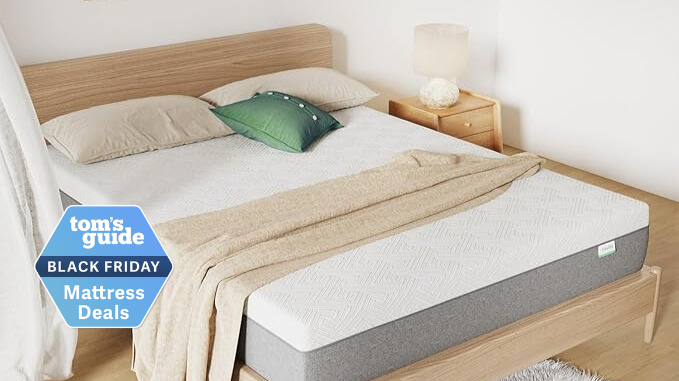







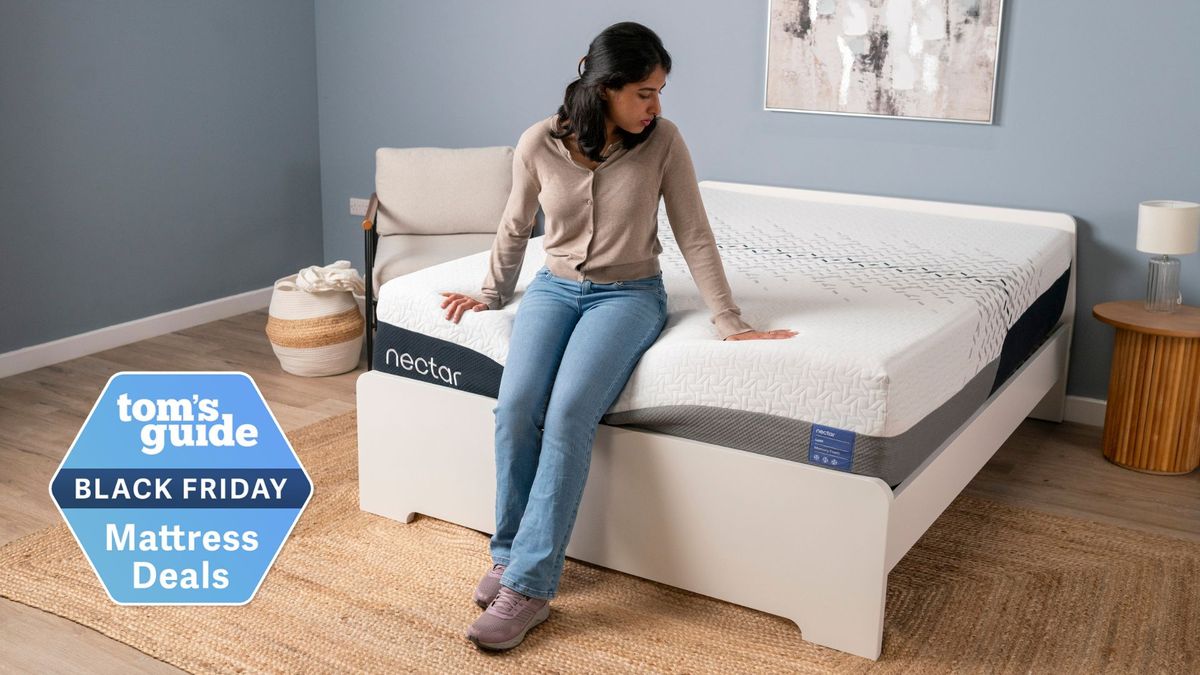









 English (US) ·
English (US) ·